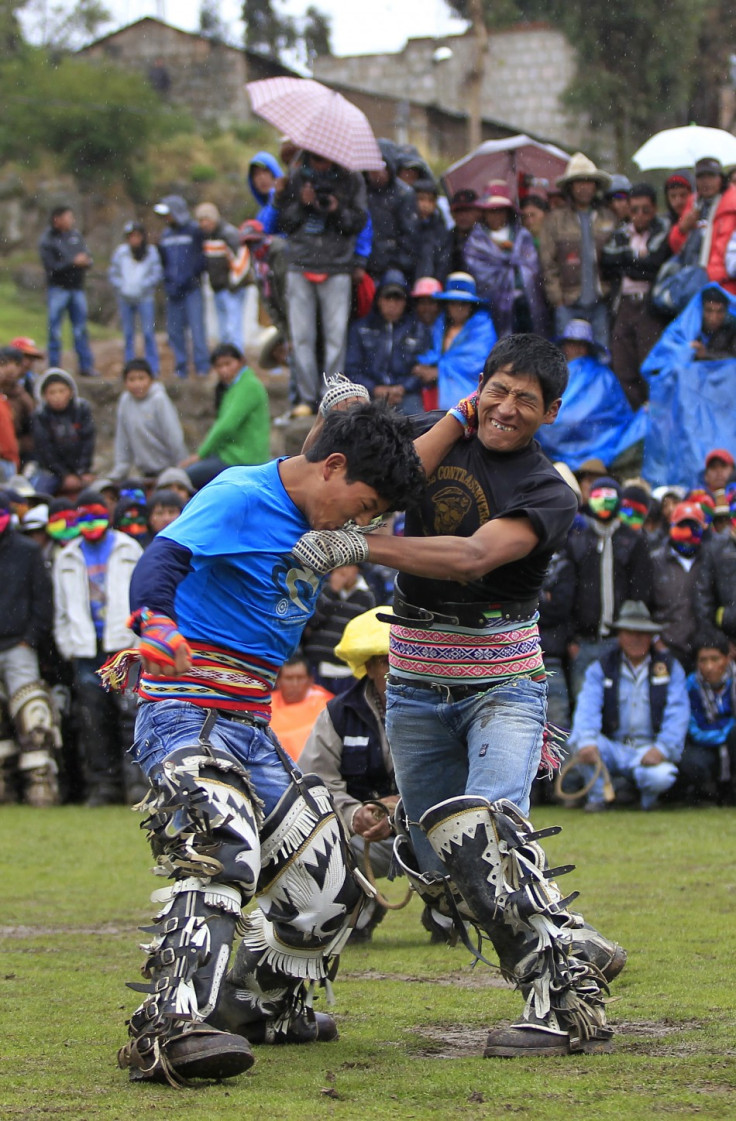Strange New Year: 10 Oddest Traditions to Bring in 2012

1. Takanakuy Festival - Peru
The New Year often heralds a new start, normally in the form of a short-lived resolution to lose weight or stop smoking but the people in Chumbivilcas, near Cuzco, really like to start with a clean slate.
During the festival, whose name translates to "when the blood is boiling", men, women and children gather in a bullring and settle scores with each other in bare-knuckle fights. Police act as referees and the competitions are based on honour rather than causing long-term injuries.
Although it may appear as an odd tradition to those outside the region, residents appear to be able to start the year on a fresh page after hugging one another before and after fights, leaving their grievances behind them.
2. Coloured Underwear - Mexico
Underwear is an important factor to most women when it comes to dressing up before a party, but in Mexico it has its own powers.
Over the New Year women shop for underwear that is coloured yellow for financial prosperity and red in the hope of being lucky in love.
3. Dinner for One - Germany
While the same films and television shows tend to make a festive appearance each year, in Germany a British cabaret sketch has become a real tradition.
Dinner for One, which is also known as The 90th Birthday, dates back to the 1920s, but a 1963 recording of the sketch has become an integral part of the German New Year TV schedule. The 18-minute video is so popular that it has been recognised by Guinness World Records as the most frequently repeated television programme.
4. Loony Dook - Scotland
Scotland celebrates New Year's Eve, or Hogmanay, in a big way. Customs include first-footing, which means being the first person to cross the threshold of a friend or neighbour, and fireball swinging. The Loony Dook is another convention, in which more than 1,000 swimmers, often adorned in fancy dress, dive into the freezing waters of the River Forth for an "invigorating" start to the New Year.
5. Celebrating with the Dead - Chile
New Year is a time of remembrance for many people. In Talca, a small town in Chile, this practice is taken a step further.
Residents prepare for New Year by gathering in the town's cemetery, where they believe their late relatives wait for them to commune with their spirits.
6. Jumping off Chairs and Breaking Dishes - Denmark
In Denmark, many people mark the first moment of New Year by jumping from their chairs in unison. Another tradition is to smash plates against a neighbour's door. Far from being an insult, the practice is a symbol of friendship. The more broken dishes that a person finds outside their door, the better they feel.
7. Grape Rating - Spain
Many people in Spain watch the clock count down to New Year with a bunch of grapes in hand.
The Spanish tradition sees revellers eat one grape for each chime of the clock. Each grape symbolises a month of the year and eating them is thought to bring good luck.
8. 108 Chimes - Japan
Everyone is used to hearing the 12 chimes that usher in the New Year but Buddhists in Japan just keep going. They ring their bells 108 times as part of the Joya no Kane tradition.
Each ring of the bell stands for a sin that a person may harbour in their heart or mind, which is expunged from the soul with each dong.
9. Water Fight - Myanmar
In Myanmar, the cleansing nature of New Year, and the fresh start that it promises, is taken literally by people who throw water on each other during the Thingyan festival.
Families and neighbours douse one another and passing cars so that everyone can start they ear with a purified soul - along with a wet T-shirt.
10. Everything Round - Philippines
People partake of circular clothing and food in the Philippines, where a rounded shape symbolises that of a coin and is thought to bring prosperity for the New Year.
People eat round food, such as grapes and oranges, and wear polka dot clothing throughout the festivities.
© Copyright IBTimes 2025. All rights reserved.




















